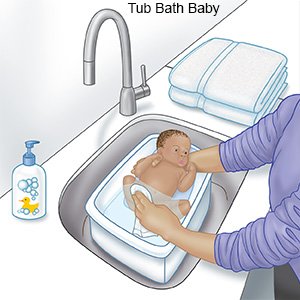Tub Bathing your Baby
Medically reviewed by Drugs.com. Last updated on Oct 29, 2024.
What do I need to know about tub bathing my baby?
You may tub bathe your baby after his or her umbilical cord falls off. If your baby was circumcised, wait until the area has healed before you bathe him or her in a tub. Bathe your baby in a baby bathtub for the first 6 months. You can also use a clean sink or plastic basin lined with a clean towel. Bathe your baby 2 or 3 times each week during the first year. Bathing more often can dry out his or her delicate skin.
What are some safety tips?
- Never leave your baby alone during a tub bath. Your baby can drown in 2 inches of water. If you must leave the room, wrap your baby in a towel and take him or her with you.
- Apply non-slip strips or stickers to the bottom of the tub. Put a soft cover over the water faucet to prevent injury.
- Do not put cotton swabs in your baby's ears. They can cause damage to your baby's ears.
How do I prepare for a tub bath?
- Keep the room warm and free of drafts. Close the door and windows, and turn off fans.
- Gather your supplies. Make sure you have everything you need within easy reach:
- Mild, unscented baby soap or shampoo
- A soft, clean washcloth
- A towel
- Diaper and wipes
- Clean clothes
- If you use a baby bathtub or basin, set it inside an adult bathtub or sink. Do not put the tub on a countertop. The countertop may become slippery and the tub can fall off.
- Fill the tub with 2 inches of warm (not hot) water. Always test the water temperature before you bathe your baby. Drip some water onto your wrist or inner arm. The water should feel warm, not hot, on your skin. If you have a bath thermometer, the water temperature should be 90°F to 100°F (32.3°C to 37.8°C). Keep your household hot water heater temperature set at less than 120°F (48.9°C) to prevent burns.
 |
How do I give my baby a tub bath?
- Slowly put your baby into the water. Keep his or her face above the water level at all times. Support the back of his or her head and neck if he or she cannot hold his or her head up. Use your free hand to wash your baby.
- Wash your baby's face and head first. Use a wet washcloth and no soap. Rinse off his or her eyelids with water. Use a clean part of the washcloth for each eye. Wipe from the inside of the eyes and out toward the ears. Wash behind and around your baby's ears. Wash your baby's hair with baby shampoo 1 or 2 times each week. Rinse well to get rid of all the shampoo. Pat his or her face and head dry before you continue with the bath.
- Wash the rest of your baby's body. Start with his or her chest. Wash under any skin folds, such as folds on his or her neck or arms. Clean between his or her fingers and toes. Wash your baby's genitals and bottom last.
- Rinse all of the soap off your baby. Soap left on your baby's skin can be irritating. Squeeze water out of washcloth and onto his or her skin, or use a container to pour water on his or her body.
- Gently pat your baby dry and wrap him or her in a towel to keep him or her warm. Baby towels with an attached hood are a great way to keep your baby's head warm. Apply a fragrance-free, hypoallergenic baby lotion or moisturizing cream to help prevent dry skin. Ask your baby's healthcare provider what type of lotion or cream is best. Dress your baby as soon as he or she is dry so he or she does not get cold.
Care Agreement
You have the right to help plan your baby's care. Learn about your baby's health condition and how it may be treated. Discuss treatment options with your baby's healthcare providers to decide what care you want for your baby. The above information is an educational aid only. It is not intended as medical advice for individual conditions or treatments. Talk to your doctor, nurse or pharmacist before following any medical regimen to see if it is safe and effective for you.© Copyright Merative 2024 Information is for End User's use only and may not be sold, redistributed or otherwise used for commercial purposes.
Further information
Always consult your healthcare provider to ensure the information displayed on this page applies to your personal circumstances.
